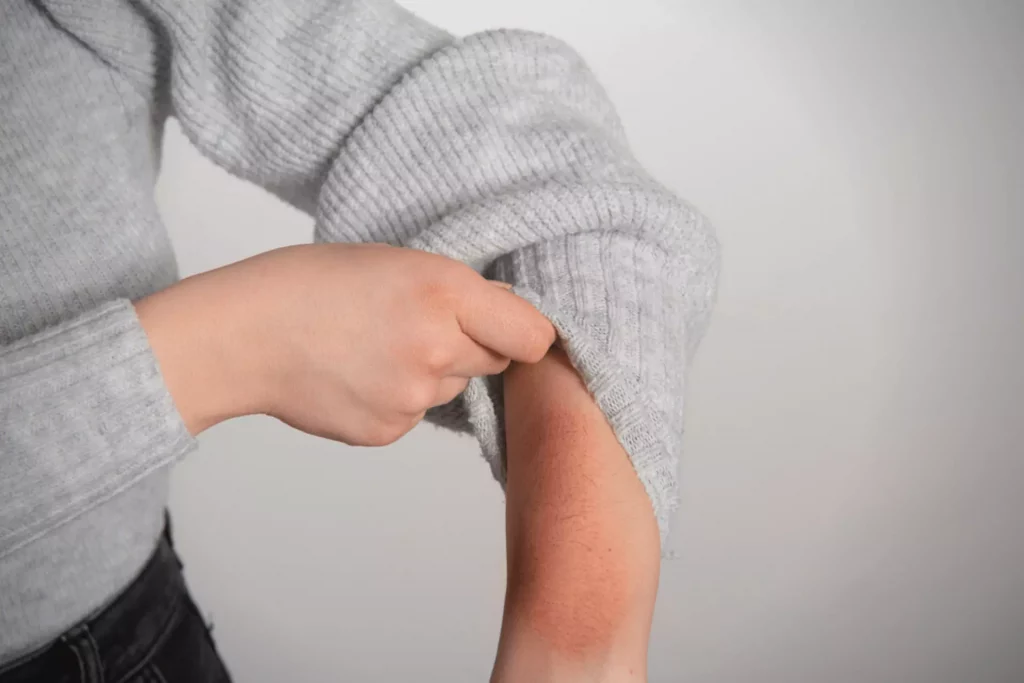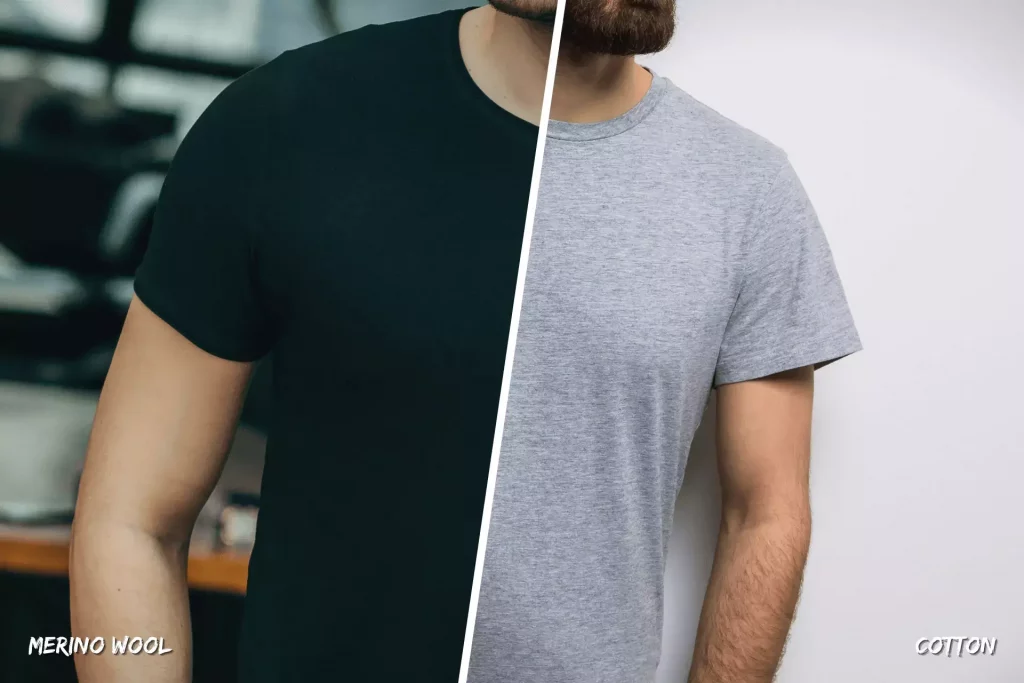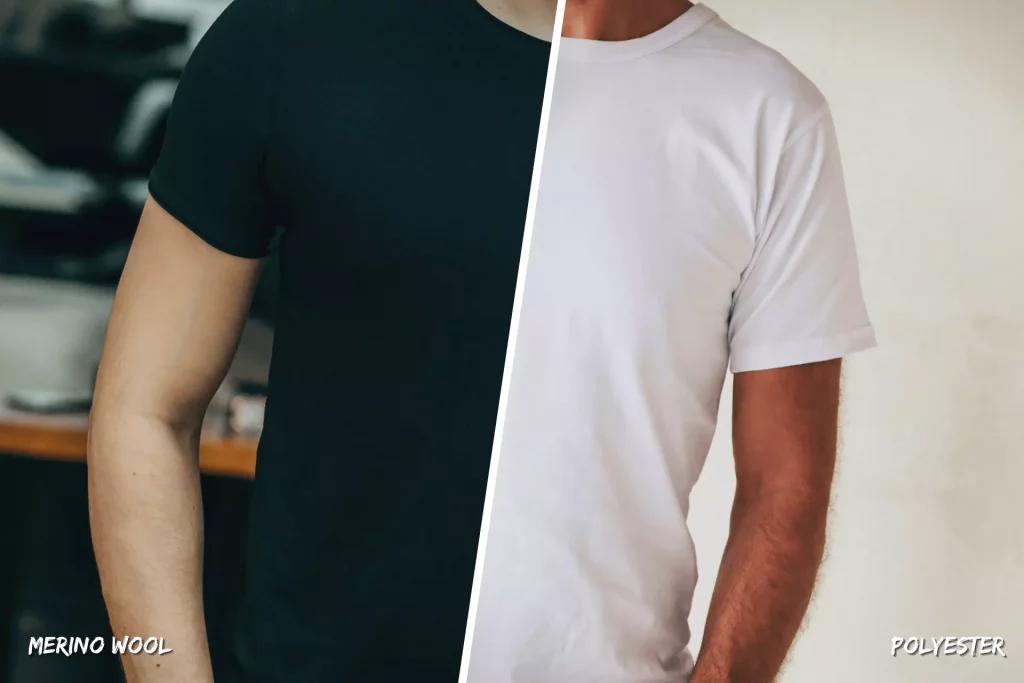The multi-purpose role of sheep in society has been played for many generations, providing both food and clothing. Our ancestors fashioned apparel clothing and blankets from the extremely versatile wool fibers, and we have witnessed Merino wool’s advancement and beginnings throughout the fabric’s history.
Recent research has revealed that wearing pure merino wool clothes can positively impact our health. According to the World Health Organization, another noteworthy application is merino wool for people with persistent skin problems, such as atopic eczema. Research has also revealed that wearing nightwear and bed linen made of pure and silky merino wool will help you sleep better and longer.
Merino wool is a fantastic and extremely versatile fiber. It is most commonly seen in producing ultra-high-quality wool socks and base layers for apparel. Base layers made of merino wool are excellent for staying warm, dry, and healthy. This article discusses how Merino wool may help you maintain a healthy lifestyle, both at work and outside of the office.
Table of Contents
A New Study Supports the Use of Merino Wool Over Polyester:
Researchers are providing fresh insight into the relationship between what individuals wear and the healthiness of their skin in a new study sponsored by AWI.
Scientists from AgResearch examined the responses of human skin to various materials – and preliminary data indicate that wearing natural fibers such as Merino wool or cotton is beneficial to skin health compared to synthetic fibers such as polyester.
Participants in this experiment wore Merino wool base-layer shirts with a patch of polyester sewn onto one part of their back for a minimum of 6 hours each day as part of their participation in the experiment.”
“We noticed that polyester tended to dehydrate the skin of those who wore it and that it also resulted in higher redness or skin irritations, particularly in men.”
In contrast, the skin coated with wool did not exhibit any harmful consequences throughout the trial. As a result, we may conclude that wool helped maintain healthy skin, but polyester had a drying impact and caused some irritation.”
In this pilot study, the performance of merino wool and cotton was comparable. The findings lend credence to the hypothesis that wearing natural fibers such as Merino wool adjacent to the skin enhances skin health. They have prompted the researchers to move forward with a second investigation stage.
In this study, volunteers are asked to wear the trial clothes constantly for five days and nights, referred to as a “long-term” wear study. Extending the amount of time that clothes are worn may allow for a distinction between the hydration benefits of Merino wool and cotton on the skin.
What Are Merino Wool’s Natural Properties?

On the surface, we can all agree that wool is a substance that keeps us warm by keeping the cold out; nevertheless, there is a little more to it than meets the eye.
Mercerized wool offers many advantages and properties that keep us warm and comfortable. A scientific study recently on fiber revealed that it has skin health benefits.
Its natural qualities make it a reusable, durable, and recyclable material, with benefits like controlling body temp and keeping a healthy micro-climate in hot and cold weather conditions.
It also naturally gathers sweat and distributes it into the air, leaving your skin dry and preventing any clammy skin, and it is naturally antibacterial.
Aside from that, merino wool has a high level of UV and smell resistance, giving it a somewhat perfect fabric to wear since it keeps you warm or cool when needed, keeps you dry when needed, and protects you from the harsh natural elements.
Biomedical Studies of Allergies to Merino Wool:

Prominent specialists undertook medical investigations in their professions – The Woolmark Company and the Queensland University of Dermatology – found that wool allergens, particularly those found in Merino wool, were harmful to adults and kids under the age of three.
The results of this research were analyzed and monitored to determine how harmful wool allergens, particularly those found in Merino wool, are.
Following the completion of the trials endorsed by The Woolmark Company and a supplementary pilot study conducted by the Queensland Institute of Dermatology.
It was discovered that wearing ultrafine Merino wool (with the fiber measuring a specific radius) near the skin has beneficial effects for both adult and newborn dermatitis sufferers, with a massive decrease in itchy skin and improved performance of physically and mentally well-being.
So, Merino wool was shown to influence skin health greatly and positively affect mental wellness. This is a great development for the wool sector, as we see more base-layer wool items making their way into stores and our lives.
The Merino wool that we have found and developed for our Store shelves will give you the style, warmth, and comfort you desire while decreasing skin sensitivities associated with wool use.
Is It Correct to Suggest That Merino Wool Helps to Strengthen the Immune System?
It is well known that getting more sleep helps to enhance one’s immune system. The difference between five and eight hours is significant in sleep quality. People who barely get six hours of sleep are four times more susceptible to infections than those who get eight hours.
In this way, Merino and all other varieties of wool help to a restful night’s sleep. The sleep issue is something that most consumers are unaware of, but it is yet another facet of increased wellbeing that can be ascribed to wool products.
The general public isn’t as aware of the health benefits of clothes as certain market segments, although there are exceptions. Firefighters, military personnel, and other first respondents are becoming increasingly conscious of the fact that their attire has an impact on their health and well-being.
An additional group that recognizes and appreciates this is the active outdoor group. Rock climbers, for example, have shared their experiences.
They’ve made it halfway up the cliff face, and the wind blows hard against them. If they’re still wearing a cotton t-shirt at that point, they’re going to be cold. After all of their efforts to get up there, the wind is blowing strong, and the temperature is frigid.
However, if they are wearing wool, the fibers are breathing and removing moisture from the body, ensuring that there is no moisture to freeze.
This makes a significant impact on their energy levels and overall comfort level. As a result, certain market segments are quite sensitive to this property of Merino and its health benefits, but not all of them.
How Does Merino Wool Compare to Cotton for Moisture-Wicking and Body Temperature Regulation?

The main distinction is that wool fiber is hydrophobic, which means that it does not like moisture on its surface, but cotton fiber does. It has a water-repelling coating on the exterior.
On the other hand, the fiber collects moisture vapor on the inside. In other words, it is particularly successful at absorbing and releasing moisture vapor, but not in absorbing and releasing liquid moisture. It has a type of repellent effect on liquid moisture.
For instance, if you’re hurrying to catch the bus and your body is in the early phases of wanting to sweat, it first produces moisture vapor before it sweats. The fibers of the wool sweater absorb the vapor.
Once it has been sucked away from the skin, the fiber transports it to the outside of the garment, where it is released into the larger environment. It draws moisture mist away from the skin and releases it back into the environment every second.
As a result, it delays the commencement of sweating since it is chilly at the time of release. Releasing has a cooling impact on the wearer’s body, a pleasant side effect.
If you’re sprinting for the bus and wearing a cotton t-shirt in a similar circumstance, the shirt is hydrophilic. Hydrophobicity is the polar opposite of hydrophobicity.
However, cotton absorbs moisture like a sponge; it is less good at transporting vapor than wool. Consequently, it allows you to sweat while sprinting for the bus, absorbing perspiration like a sponge and retaining moisture.
Cotton clothing, as a result, can cause the wearer’s core body temperature to drop when the surrounding environment temperature dips for whatever reason.
When the sun sets or the wind blows, it is time to call it a day. However, if you wear a Merino wool shirt, your skin will be dry or dryer.
In an ideal situation, it has prevented the commencement of sweating by removing moisture vapor from the skin as quickly as possible. However, if the body sweats more quickly than the wool can react, this does not occur.
Even Soaked in Water, Wool Does Not Freeze Like Cotton. What’s the Deal?
Merino wool clothing has an exothermic effect. In other words, absorbing moisture results in the generation of heat. The fact that wool is hydrophobic, as previously stated, has a role to play in this phenomenon.
Because it does not contain any moisture on the outside, it does not feel clammy or chilly to the touch. It doesn’t feel moist since it’s not a sponge in the traditional sense.
It delays the onset of sweating, but it also ensures that the sweat does not sweat the garment’s surface when it does occur. It doesn’t become wet and squishy since it has a hydrophobic coating. So that’s the most significant change, and it’s fairly obvious.
What Do You Think About Merino Shirts Over Polyester Shirts?

Although polyester does not absorb moisture vapor, it may be modified to be either polar or hydrophilic based on the manufacturing technique used.
Normally, it begins out hydrophobic, but it may be created so that it becomes hydrophilic once it has been finished applying it. However, because it does not absorb vapor, it has little effect on delaying sweating.
You’ll sweat just as much in polyester as in cotton, if not more than in cotton. Apart from that, once it has been used, it usually absorbs the odor of the person wearing it.
As a frequent rider, I can nearly smell myself before I get to the end of the driveway if I don’t wear my polyester clothing. The scents are absorbed and locked away inside my Merino wool clothing fibers, which are then released in the wash when I wash them.
Polyester is probably somewhere between Wool and cotton for rock climbers in softness. When they’re halfway up the stone face, they’ll be able to tell the difference between the variations in comfort and performance.
Merino Wool and cotton are presumably at the extremities of the spectrum, with polyester somewhere in between. If they’re rock climbing for three days straight, they’ll sometimes smell their body odor, and it isn’t going away in polyester.
That Merino Wool Keeps You Warm and Cool Sounds Very Comparable. Can You Tell the Difference?

The mechanism through which wool absorbs moisture from the skin is exothermic. In other words, it generates heat. The fact that you’re sweating indicates that you’re becoming hotter.
However, this evaporative process is a cooling process since it transfers moisture into the atmosphere. One is assisting the other to a certain extent. However, I like to think about it because wool contributes to creating a more stable microclimate.
It is not subjecting the body to abrupt shifts in one direction or the other. We can withstand a good amount of cold and withstand a significant amount of heat.
The quick transition from one to the other, on the other hand, is something that people cannot handle, and here is where wool is advantageous. It allows the body to acclimate and acclimatize to the new environment by bringing the temperature down gradually.
When the weather extremes are removed, the body may acclimatize more slowly to its new environment. And that’s what I believe the rock climbers are experiencing; they aren’t experiencing any rapid changes in body temperature.
Wool Is Antibacterial and Antimicrobial, According to Merino Garments. Experts on Wool Believe It’s Neither. Describe?

Wool has two distinguishing characteristics, one of which you noted because germs cannot flourish in this environment because it controls the microclimate between the skin and the clothing and prevents it from becoming damp.
The number of bacteria is lower in that warmer microclimate because they do not increase as much in that warmer microclimate as if you were dressed in cotton or polyester.
Sweat does not have a distinct odor; rather, bacteria produce scents that get access to sweat and multiply. So it’s antibacterial because it decreases or restricts the reproduction of germs, which is a general definition. That is the first point to make.
It’s also worth noting that, after the lanolin has been removed during processing (there is very little lanolin left on a wool garment because it is almost entirely removed during processing), there is a thin layer of lipid that forms on the surface of the fiber that has characteristics similar to some antibacterial products.
However, it is genuinely antibacterial and is not something we are certain about. In addition, we do not make any claims about wool being antibacterial on our website or actively advertise the fact that wool is antibacterial.
A contributing factor is that it biodegrades rather quickly, given the end of its useful life, given the proper environment, particularly in a wet climate.
Many germs are also eating away at the wool at that point. We can’t have it both ways at the same time. We can’t declare something is antibacterial over its whole life cycle and then claim that bacteria consume it after its cycle.
Once again, it is only when the wool is exposed to a damp, warm environment that it begins to biodegrade quickly. On the other hand, Wool was discovered in the pyramids of Giza.
Because it was kept in a dry, cold environment, it was still in fantastic shape despite being 5,000 years old. We say that wool inhibits the reproduction of microorganisms that cause odor. That’s as far as we’re going to get.
It is not common knowledge that odor tolerance can be enhanced by the uptake organic compounds (VOCs). That applies to woolen carpets and textiles, where you get this ill building syndrome, which is a problem in the construction industry.
Formaldehyde and other volatile organic compounds (VOCs) are released from the timber and walls of some buildings. Using textiles on the walls, such as wool curtains and wool rugs, you can absorb VOCs and keep them locked away. As a result, those characteristics were well-documented in the early twentieth century.
What Effect Does Wool Clothing Have On Skin Health if It Prevents Bacterial Growth?
It is the same functionality that is used to manage the microclimate. Eczema is an excellent illustration of this. Eczema patients have very dry skin that sheds moisture alarmingly rapidly. The moisture evaporates from their skin, causing the skin to crack.
Bacteria then colonize the fissures, causing the redness, itching, and agony of eczema. However, because wool regulates the microclimate, it does more than transport moisture away from the skin and into the surrounding environment.
It also serves to draw moisture from the surrounding environment into the microclimate, where it serves to buffer the relative temperature and relative humidity in that microclimate.
This means it works the opposite way for eczema sufferers, rather than the previous example of frantically hurrying to catch the bus and drawing moisture vapor from the skin.
In this situation, it draws moisture from the outside and keeps their skin a little drier. The use of merino wool garments helps minimize the effects of temperature and relative humidity fluctuations.
It protects you from unexpected shifts since it continually buffers the environment by transferring moisture in one direction. The body does not tolerate rapid fluctuations when it comes to heat regulation.
On the other hand, Wool prefers to maintain its equal and balanced appearance. By drawing the temperature and humidity in one direction through the cloth, it helps to level out the temperature and humidity.
More moisture on the outside causes it to draw more moisture from the inside. On the other hand, if more moisture is within, it will force the surplus moisture out. This is how wool aids in the regulation of the body’s temperature.
In this regard, it outperforms cotton by a factor of two, and it outperforms polyester by a factor of around three. It operates similarly while rushing for the bus: if your skin produces a lot of moisture vapor, the wool will take it out and release it into the atmosphere.
However, if you suffer from eczema and have dry skin, wearing wool clothing will cause it to flare up in the other manner. It maintains a continual state of equilibrium, allowing the temperature and humidity in the area between the body and the fabric to be buffered.
Does Wearing Merino Wool Clothes Help You Sleep Better and Relax Than Sleeping in Wool Bedding?

This study on sleep health-focused just on apparel, with no other variables considered. These 36 adults, who you can see above, slept in either Merino wool jammies, cotton pajamas, or polyester pajamas, depending on their preference.
They had nothing to sleep on: no blankets, no comforters, nothing. As a result, we didn’t want the study results to be influenced by additional layers of bedding.
We were able to convince them to sleep exclusively in their pajamas. Their sleep patterns were next monitored using sleep-dialysis equipment, which measured how profoundly they slept, how long they slept, how many waking episodes they had, and how soon they went asleep each night.
Essentially, all of the tested indicators improved when the wool was used. The wool pajamas group did not perform statistically considerably better than the rest, but everything was better for them.
Compared to cotton or polyester, Merino wool provided significantly less fragmented sleep, a statistically significant finding. Polyester, for example, is 12 percent less fractured than cotton.
As a result, individuals either woke up less frequently or transitioned from deep slumber to light sleep more frequently, less common in wool. They also reported a quicker beginning of sleep. Particularly prevalent among those over the age of 65 was this phenomenon.
They fell asleep in an average of 12 minutes, compared to 27 minutes for the group that wore cotton clothing. The customer must measure the value of those extra fifteen min spent looking at the ceiling against the benefits of doing so. However, we considered a rather significant amount of additional sleep time.
Another aspect to mention is that there are higher advantages at the extremes. For example, we found that when we looked at the people who gained the most among those aged 50 to 70.
The older persons, those with a higher body mass index, and those who were intrinsically bad sleepers were shown to be the worst.
In other words, it comes down to the same thing: if you’re on the periphery of the distribution, you’re more likely to reap the benefits of wool in a statistically meaningful manner.
Eczema is more prevalent at one end of the distribution spectrum than at the other end of the spectrum in terms of skin health. Eczema affects around one-quarter of all infants born into a Western-style lifestyle.
When I say Western, you might think of places like Europe, America, and Australia. But that’s not the only thing that’s happening. Western, on the other hand, is presently Hong Kong and China.
They’re all making the transition to Western ways of living. Unfortunately, due to this, people are developing allergies to the environment.
In general, the more away you are from the land or animals and how humans connect with the globe, the more probable you may develop an allergic reaction to the earth.
Is It the Urban Lifestyle That Causes Skin Issues in Children?

Yes. You have skin problems, but you also have many allergy issues. When I observe children with red skin, the dermatologists with whom I work question the moms, “Was your child born through Cesarian section or naturally?”
What kind of upbringing did you provide for your child? Was he reared on a farm or in the city?’ They are exposed to nature while working on a farm. ‘Did you have pets while your child was a child, or did you raise without pets?’
Pets are extremely adept at disseminating parasites. Their purpose in asking these questions is to determine how far distant your child is from stone-age humans.
The more we get away from that, the more probable it is that you will develop an allergy to the environment when exposed to things you were not exposed to as a child.
When it comes to eczema patients, the age range of 0-5 years old is the most vulnerable. Cesarean birth, for example, is associated with an increase in risk because the mother and child are not exposed to all that occurs at the lower end of the body during birth, which is dangerous.
They become coated with many things, which prelude their exposure to the rest of the world.
In this study, conducted at Murdoch’s Children’s Research Institute, 40 children from 0 to 3 years participated. In addition, they compared cotton garments against a base layer made of superfine Merino wool.
The study used a crossover design, in which half of the 40 children wore cotton for six weeks before switching to wool for another six. During the transition from one fiber to the next, the participants’ eczema symptoms were observed and recorded.
After a few months, the other half began with wool and then switched to cotton. The polar opposite of the first group. They dubbed the second group “wool first,” whereas the other group was designated “cotton first.”
When they switched to Merino wool, their problems disappeared almost immediately between weeks 9 and 12. As soon as the first wool group began wearing wool, their symptoms continued to subside.
When they switched to cotton, their symptoms reverted to a similar state to when they first started. This crossover design is the most popular among scientists since it allows them to experiment with different treatments and see what happens.
We’re talking about newborns with soft skin dressed in Merino wool, but many people still believe that wool is scratchy due to this misconception. They are taken aback by the fact that they can wear a Merino wool shirt without becoming uncomfortable or scratchy.
Although wearing Merino wool can be quite comfortable, the softness of the wool is considered medicinal for the skin rather than an irritation to be tolerated, as is the case with cotton.
Can We Presume That if Merino Wool Is Good for the Body, It Is Also Good for the Mind and Emotions?
Next on our list is cognitive health, which we are quite interested in. We want to put individuals under stress through their paces to see how they react. Suppose a pilot is landing a plane in terrible weather and everything is going wrong.
Would he be calmer and collected if he was wearing a Merino wool base layer rather than another type of fiber because his body is thermoregulating better, and he is more calm and collected? Is he more likely to make better judgments in that situation?
The same may be said for the general contemplating sending his soldiers over the hill to engage the opposition. Is it more likely that he will make a better judgment if he wears Merino wool rather than another sort of fiber? This is an area of investigation that we have not yet begun.
Frequently Asked Questions:
What are some of the drawbacks of utilizing Merino wool?
Even though Merino is an excellent temperature-regulating fabric, it is also a fragile cloth. Because it is so thin, many lightweight gears (140 – 180 GSM) are particularly poor durability. Additionally, holes can sometimes emerge due to repeated use and cleaning.
Is it true that Merino wool has antimicrobial properties?
Odor-resistant: Merino wool has antibacterial characteristics due to the natural lanolin found in the sheep’s wool, which helps repel microorganisms that cause odor. Because merino wool is effective at managing moisture, there is no damp environment where the bacterium may thrive.
Is merino wool a superior material to cashmere?
When compared to Merino wool, cashmere is a softer material. In modern times, wool is handled with fabric softeners, and the result is a fabric that is noticeably more supple than it was in the past. When it comes to durability, Merino wool outperforms Cashmere, and it requires less maintenance than compared to Cashmere as well.
Bottom Line:
Because merino wool helps regulate body temperature and wicks perspiration away from the body, it is warm in the winter and cools in the summer, depending on the season. It has naturally occurring anti-microbial and odor-resistant properties, which keep you smelling fresh. Merino wool is luxuriously soft and comfy, and it keeps you warm and comfortable.

